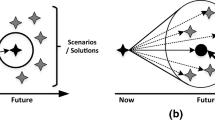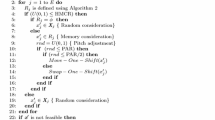Abstract
The nurse rostering problem (NRP) is a representative of NP-hard combinatorial optimization problems. The hardness of NRP is mainly due to its multiple complex constraints. Several approaches, which are based on an evolutionary algorithm (EA) framework and integrated with a penalty-function technique, were proposed in the literature to handle the constraints found in NRP. However, these approaches are not very efficient in dealing with large-scale NPR instances and thus need to be improved upon. In this paper, we investigate a large-scale NRP in a real-world setting, i.e., Chinese NRP (CNRP), which requires us to arrange many nurses (up to 30) across a 1-month scheduling period. The CNRP poses various constraints that lead to a large solution space with multiple isolated areas of infeasible solutions. We propose a single-individual EA for the CNRP. The novelty of the proposed approach is threefold: (1) using a constraint separation to partition the constraints into hard and soft constraints; (2) using a revised integer programming to generate a high-quality initial individual (solution), which then leads the subsequent EA search to a promising feasible solution space; and (3) using an efficient mutation operator to quickly search for a better solution in the restricted feasible solution space. The experimental results based on extensive simulations indicate that our proposed approach significantly outperforms several existing representative algorithms, in terms of solution quality within the same calculation times of the objective function.







Similar content being viewed by others
References
Burke EK, De Causmaecker P, Vanden Berghe G, Landeghem H (2004) The state of the art of nurse rostering. J Sched 7(6):441–499
Sitompul D, Randhawa S (1990) Nurse scheduling models: a state-of-the-art review. J Soc Health Syst 2:62–72
Hung R (1995) Hospital nurse scheduling. J Nurs Adm 25(7–8):21–23
Cheang B, Li H, Lim A, Rodrigues B (2003) Nurse rostering problems—a bibliographic survey. Eur J Oper Res 151:447–460
Aickelin U, Burke EK, Li J (2009) An evolutionary squeaky wheel optimization approach to personnel scheduling. IEEE Trans Evol Comput 13(2):433–443
Beaumont N (1997) Scheduling staff using mixed integer programming. Eur J Oper Res 98:473–484
Warner M, Prawda J (1972) A mathematical programming model for scheduling nursing personnel in a hospital. Manag Sci 19:411–422
Warner DW (1976) Scheduling nurse personnel according to nursing preference: a mathematical programming approach. Oper Res 24(5):842–856
Aickelin U, Dowsland K (2000) Exploiting problem structure in a genetic algorithm approach to a nurse rostering problem. J Sched 3:139–153
Burke EK, Cowling P, De Causmaecker P, Vanden Berghe G (2001) A memetic approach to the nurse rostering problem. Appl Intell 15:199–214
Easton FF, Mansour N (1999) A distributed genetic algorithm for deterministic and stochastic labor scheduling problems. Eur J Oper Res 118:505–523
Kawanaka H, Yamamoto K, Yoshikawa T, Shinigi T, Tsuruoka S (2001) Genetic algorithm with the constraints for nurse scheduling problem. In: Proceedings of congress on evolutionary computation (CEC), pp 1123–1130
Burke EK, De Causmaecker P, Vanden Berghe G (1999) A hybrid tabu search algorithm for the nurse rostering problem. In: Proceedings of the simulated evolution learning: selected papers 2nd Asia-Pacific conference simulated evolution learning. (SEAL), Lecture Notes in Computer Science Series 1585. Springer, Berlin, pp 187–194
Burke EK, De Causmaecker P, Petrovic S, Vanden Berghe G (2001) A multicriteria meta-heuristic approach to nurse rostering. In: Proceedings of the practice theory automated timetabling: selected revised papers 3rd practice theory automated timetabling international conference, Lecture Notes in Computer Science Series 2079. Springer, Berlin, pp 118–131
Burke EK, De Causmaecker P, Petrovic S, Vanden Berghe G (2006) Metaheuristics for handling time interval coverage constraints in nurse scheduling. Appl Artif Intell 20(9):743–766
Beddoe G, Petrovic S (2006) Selecting and weighting features using a genetic algorithm in a case-based reasoning approach to personnel rostering. Eur J Oper Res 175(2):649–671
Burke EK, Li J, Qu R (2010) A hybrid model of integer programming and variable neighbourhood search for highly-constrained nurse rostering problems. Eur J Oper Res 203:484–493
Tsai C-C, Li SHA (2009) A two-stage modeling with genetic algorithms for the nurse scheduling problem. Expert Syst Appl 36:9506–9512
Pato MV, Moz M (2008) Solving a bi-objective nurse rerostering problem by using a utopic Pareto genetic heuristic. J Heuristics 14:359–374
Cheng BMW, Lee JHM, Wu JCK (1997) A constraint-based nurse rostering system using a redundant modeling approach. IEEE Trans Inf Technol Biomed 1:44–54
Sheer BB, Wong FKY (2008) The development of advanced nursing practice globally. J Nurs Scholarsh 40(3):204–211
Bai R, Burke EK, Kendall G, Li J, McCollum B (2010) A hybrid evolutionary approach to the nurse rostering problem. IEEE Trans Evol Comput 14(4):580–590
Wolfe H, Young JP (1965) Staffing the nursing unit: part I. Nurs Res 14(3):236–243
Wolfe H, Young JP (1965) Staffing the nursing unit: part II. Nurs Res 14(4):199–303
Howell JP (1966) Cyclical scheduling of nursing personnel. Hospitals 40(2):77–85
Bard J, Purnomo HW (2005) Preference scheduling for nurses using column generation. Eur J Oper Res 164:510–534
Berrada I, Ferland JA, Michelon P (1996) A multi-objective approach to nurse scheduling with both hard and soft constraints. Socio Econ Plan Sci 30:183–193
Ikegami A, Niwa A (2003) A subproblem-centric model and approach to the nurse scheduling problem. Math Program 97:517–541
Hadwan M, Ayob M, Sabar NR, Qu R (2013) A harmony search algorithm for nurse rostering problems. Inf Sci 233:126–140
Post G, Veltman B (2004) Harmonious personnel scheduling. In: Proceedings of the fifth international conference on practice and automated timetabling (PATAT), pp 557–559
Burke EK, Curtis T, Post G, Qu R, Veltman B (2008) A hybrid heuristic ordering and variable neighbourhood search for the nurse rostering problem. Eur J Oper Res 188:330–341
Dowsland KA (1998) Nurse scheduling with tabu search and strategic oscillation. Eur J Oper Res 106(2–3):393–407
Burke EK, Kendall G, Soubeiga E (2003) A tabu-search hyperheuristic for timetabling and rostering. J Heuristics 9(6):451–470
Aickelin U, Dowsland KA (2003) An indirect genetic algorithm for a nurse scheduling problem. Comput Oper Res 31(5):761–778
Aickelin U, Burke EK, Li J (2007) An estimation of distribution algorithm with intelligent local search for rule-based nurse rostering. Eur J Oper Res 58(12):1574–1585
Bai R, Blazewicz J, Burke EK, Kendall G, McCollum B (2007) A simulated annealing hyper-heuristic methodology for flexible decision support. School of CSiT, Univ. Nottingham, Nottingham, UK, Tech. Rep. NOTTCS-TR-2007-8
Awadallah MA, Khader AT, Al-Betar MA et al (2011) Nurse rostering using modified harmony search algorithm/Swarm, evolutionary, and memetic computing. Springer, Berlin, pp 27–37
Acknowledgments
This work was supported by National Natural Science Foundation of China (61370102, 61170193, 61202453, 61203310), Guangdong Natural Science Foundation (S2011040002890, S2012010010613), the Fundamental Research Funds for the Central Universities, SCUT (2012ZZ0087, 2014ZG0043) and The Pearl River Science&Technology Star Project (2012J2200007). The authors thank Dr. Kyle McIntosh for his proofreading.
Author information
Authors and Affiliations
Corresponding author
Rights and permissions
About this article
Cite this article
Huang, H., Lin, W., Lin, Z. et al. An evolutionary algorithm based on constraint set partitioning for nurse rostering problems. Neural Comput & Applic 25, 703–715 (2014). https://doi.org/10.1007/s00521-013-1536-2
Received:
Accepted:
Published:
Issue Date:
DOI: https://doi.org/10.1007/s00521-013-1536-2




